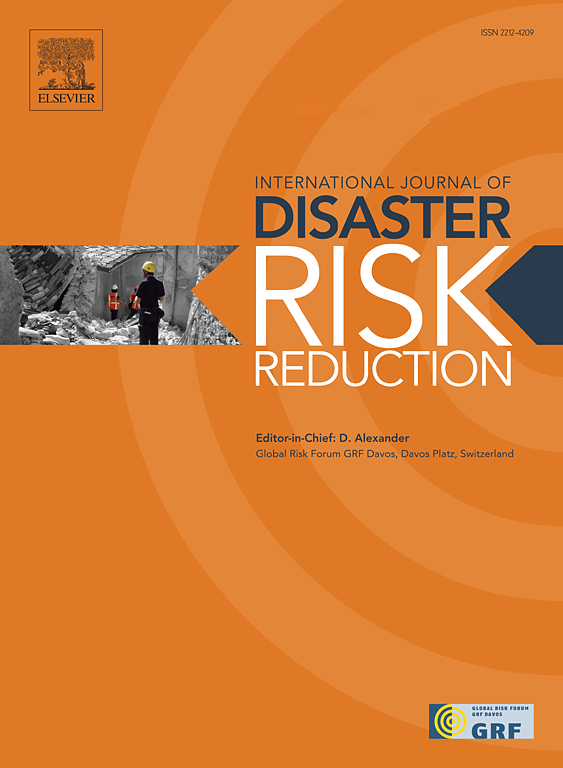An adaptation and validation of the Baseline Resilience Indicators for Communities (BRIC): A case study of South Korea
IF 4.2
1区 地球科学
Q1 GEOSCIENCES, MULTIDISCIPLINARY
International journal of disaster risk reduction
Pub Date : 2025-06-09
DOI:10.1016/j.ijdrr.2025.105634
引用次数: 0
Abstract
Community resilience plays a critical role in mitigating disaster impacts and facilitating recovery. This study constructs a resilience index for South Korea, adapted from Cutter's BRIC framework, with modifications to better reflect local contexts. We validated the index using natural hazard losses and external cause mortality, with particular emphasis on the latter as an objective measure of resilience. The results showed that higher resilience scores were associated with reduced damage and mortality, underscoring the index's effectiveness. However, institutional resilience and community capital unexpectedly correlated positively with damage and mortality, although this effect diminished in further regression models that controlled for rural status. These findings highlight disparities between metropolitan and rural areas. Spatial analysis supported this finding, with metropolitan areas like Seoul and Busan exhibiting higher resilience compared to rural regions. By emphasizing the feasibility and utility of external cause mortality as a validation metric, this study contributes to the development of a robust tool for assessing resilience and guiding targeted policy interventions to strengthen community resilience.
社区基线恢复力指标(金砖四国)的调整与验证:以韩国为例
社区复原力在减轻灾害影响和促进恢复方面发挥着关键作用。本研究根据卡特的金砖四国框架为韩国构建了一个弹性指数,并进行了修改,以更好地反映当地情况。我们使用自然灾害损失和外因死亡率验证了该指数,特别强调后者作为恢复力的客观衡量标准。结果显示,复原力得分越高,破坏和死亡率越低,强调了该指数的有效性。然而,制度弹性和社区资本意外地与损害和死亡率呈正相关,尽管这种影响在控制农村状况的进一步回归模型中有所减弱。这些发现突出了大都市和农村地区之间的差异。空间分析支持了这一发现,与农村地区相比,首尔和釜山等大都市地区表现出更高的弹性。通过强调外因死亡率作为验证指标的可行性和实用性,本研究有助于开发一个强大的工具来评估复原力和指导有针对性的政策干预,以加强社区复原力。
本文章由计算机程序翻译,如有差异,请以英文原文为准。
求助全文
约1分钟内获得全文
求助全文
来源期刊

International journal of disaster risk reduction
GEOSCIENCES, MULTIDISCIPLINARYMETEOROLOGY-METEOROLOGY & ATMOSPHERIC SCIENCES
CiteScore
8.70
自引率
18.00%
发文量
688
审稿时长
79 days
期刊介绍:
The International Journal of Disaster Risk Reduction (IJDRR) is the journal for researchers, policymakers and practitioners across diverse disciplines: earth sciences and their implications; environmental sciences; engineering; urban studies; geography; and the social sciences. IJDRR publishes fundamental and applied research, critical reviews, policy papers and case studies with a particular focus on multi-disciplinary research that aims to reduce the impact of natural, technological, social and intentional disasters. IJDRR stimulates exchange of ideas and knowledge transfer on disaster research, mitigation, adaptation, prevention and risk reduction at all geographical scales: local, national and international.
Key topics:-
-multifaceted disaster and cascading disasters
-the development of disaster risk reduction strategies and techniques
-discussion and development of effective warning and educational systems for risk management at all levels
-disasters associated with climate change
-vulnerability analysis and vulnerability trends
-emerging risks
-resilience against disasters.
The journal particularly encourages papers that approach risk from a multi-disciplinary perspective.
 求助内容:
求助内容: 应助结果提醒方式:
应助结果提醒方式:


